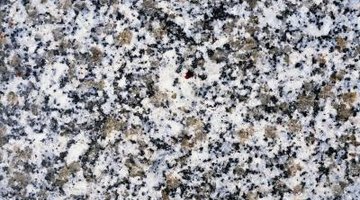Quartz Monzonite Vs. Granite
Quartz monzonite, also called adamellite, and granite are both granitic rocks with visible grains that bear a superficial resemblance to one another. Granitic rocks are igneous, meaning they were formed by heat under the crust of the earth. Quartz monzonite contains 5 to 20 percent quartz. Granite contains 20 to 60 percent quartz. Both quartz monzonite and granite are quarried, cut and polished for similar construction uses.
Quartz

Quartz, a natural form of silicon dioxide found in both quartz monzonite and granite, is found in a large range of colors and varieties and, after feldspar, is the most common mineral on the earth's surface. Many varieties of quartz crystals are used to make jewelry and carvings. Agates are a form of quartz crystals.
Quartz Monzonite
In addition to quartz, quartz monzonite contains K-feldspar, which is similar to quartz; plagioclase feldspar, which has a grainy, gray appearance; and one or more dark-colored mafic minerals. Mafic minerals commonly include iron and magnesium, plus calcium and sodium. Quartz monzonite has building characteristics similar to granite and is often and cut and polished for countertops and stone veneer. Stone Mountain, Georgia, is made of quartz monzonite. Blocks of quartz monzonite quarried from Little Cottonwood Canyon, Utah, were used to build the Mormon temple in Salt Lake City and the Utah state capitol.
Granite
Granite is light-colored, white, gray, pink or red and is sprinkled with visible crystals or grains of dark minerals. In addition to quartz, granite contains 10 to 65 percent feldspar, with smaller amounts of amphiboles, micas and other minerals. Some 60 percent of the earth's outer crust is made of feldspar that consists of aluminum silicates plus calcium, potassium, sodium and sometimes barium. Amphiboles contain combinations of aluminum, calcium iron, magnesium and sodium. Micas are aluminum silicates that separate into thin sheets. Granite is hard enough to polish and resists scratches and scrapes. It is strong enough to bear heavy weight, so it has been used to build monuments, buildings and bridges. Most granite in the United States is quarried in Georgia, Idaho, Massachusetts, New Hampshire and South Dakota.
Uses
The ancient Greeks and Romans used quartz monzonite to build many of their monuments and buildings, and also to create sculptures. The four presidents depicted on Mt. Rushmore in South Dakota are carved in granite. People who sell stone for countertops, tile and veneer often use the name "granite" to describe any rock that is harder than marble and contains visible grains. Since quartz monzonite looks like granite and has similar construction characteristics, building suppliers commonly market it as "granite." Both stones are heavy and costly to ship. Their availability and cost usually depend on how close you are to quarries that supply them.
References
Resources
Photo Credits
- Goodshoot/Goodshoot/Getty Images
More Articles



